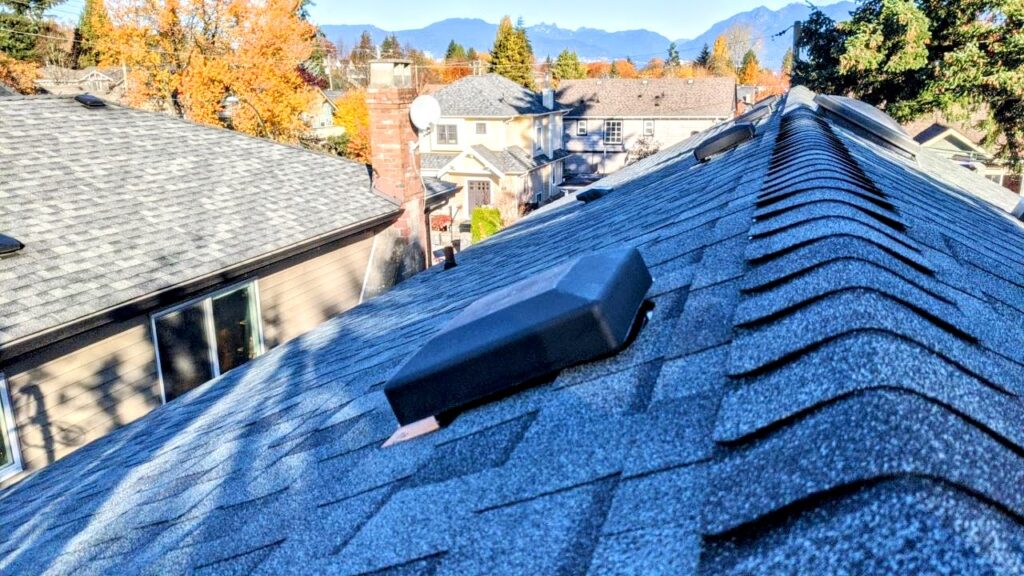Ever noticed tiny grains in your gutters or scattered around your downspouts after a storm? Don’t ignore them. Those little granules might be coming from your roof shingles, and they’re not just cosmetic. Granule loss can be an early warning sign that your roof is at risk.
Roof shingles, especially asphalt shingles, rely on those granules to protect your home from UV rays, moisture, and fire. Losing them could mean your roof is aging faster than expected, or suffering from hidden damage. In this blog, we’ll break down what granule loss means, when to take action, and what experienced roofing contractors recommend.
What Are Roof Shingles Made Of?
To understand why granule loss matters, let’s first look at what roof shingles are made of.
Most homes in Canada use asphalt shingles, which are composed of three key layers:
- A fiberglass mat for structure
- Asphalt coating for waterproofing
- Mineral granules for UV protection and fire resistance
These granules also provide the color and texture of your shingle roofing. Without them, the asphalt layer is exposed—leading to rapid deterioration.
According to the National Roofing Contractors Association’s Steep-Slope Roofing Materials Guide, granules on roof shingles serve not only as a design element but also as a critical protective barrier against UV radiation and weathering.
Why Granule Loss Happens in Roof Shingles
It’s natural for some granules to wear off over time. However, excessive or sudden granule loss may point to deeper issues. Here are a few common causes:
- Age: Older shingle roofs naturally lose granules over time, especially after 15–20 years.
- Weather exposure: Harsh sun, wind, and heavy rain can dislodge granules.
- Hail damage: Impact from hailstones can strip granules from roof shingles.
- Poor ventilation: Inadequate attic ventilation can overheat the roof, leading to deterioration.
- Foot traffic: Walking on your shingle roofing can grind off protective layers.
7 Warning Signs Your Roof Shingles Are Losing Granules
Here are seven red flags that suggest your roof shingles may be in trouble. Ignoring these signs can lead to bigger issues like roof leaks, poor insulation, or even structural damage—so early detection is key to protecting your home and avoiding costly repairs down the line:
- Granules in Gutters or Downspouts
If you’re cleaning your gutters and notice sand-like debris, it’s likely granules that have worn off your asphalt shingles. - Bald Spots on Roof Shingles
Look for dark patches where granules have worn off and the asphalt layer underneath is exposed—this is a major vulnerability to sun and water damage. - Color Inconsistency Across the Roof
Uneven fading or discoloration may indicate granule loss in specific areas, especially on older shingle roofs or those exposed to harsh weather. - Curling or Cracking Asphalt Shingles
Brittle, cracked, or curled asphalt shingles often go hand-in-hand with excessive granule shedding, signaling the need for professional inspection. - Granules in Driveways or Lawns After Rain
If you spot dark specks around your home after heavy rain, check your roof. Runoff can carry granules away from your roof shingles and into surrounding areas. - Visible Damage After a Storm
Storms can cause immediate granule loss—especially if there’s hail, fallen branches, or strong winds battering your shingle roofing. - Moss or Algae Growth
Moss can trap moisture and lift shingles, stripping away granules and exposing your roof to long-term decay. If left untreated, it can shorten your roof’s lifespan significantly.
Should You Be Worried About Granule Loss in Roof Shingles?
Short answer: yes—but it depends on the cause.
If your roof shingles are brand new, a small amount of granule loss is normal. This is known as “shed-off” and happens during the first few months. However, excessive or uneven granule loss can weaken your roof’s protective layer and lead to:
- Water leaks
- Mold or mildew buildup
- Reduced energy efficiency
- Shortened roof lifespan
In many cases, granule loss is just the beginning of a larger problem. It often goes hand-in-hand with other issues like blistering, cracking, or curling. If you’re noticing multiple signs of wear, it may help to review this list of 7 Common Problems with Shingle Roofing (and How to Fix Them) for a clearer picture of what might be happening on your roof.
Searching for ‘professional roofing contractors near me’ in Google can assess whether you’re dealing with normal wear or something more serious.
What to Do If You Notice Granule Loss
Don’t panic—but don’t delay, either. Granule loss might seem minor, but it can quickly lead to leaks or deeper roof damage if ignored. Here are some proactive steps you should take:
- Inspect the damage safely from the ground or use a drone to avoid walking on the roof and dislodging more granules.
- Check the attic for signs of leaks, moisture stains, or daylight peeking through—these could signal that your roof shingles are already compromised.
- Document the issue with clear photos or videos, especially if you’re planning to file an insurance claim for roof damage.
- Contact roofing contractors near you for a thorough inspection, expert opinion, and a repair or replacement quote before the problem worsens.
How Roofing Contractors Handle Granule Loss in Shingle Roofing
Depending on the severity, roofing professionals may recommend:
- Spot repairs or sealing
- Replacing individual roof shingles
- Installing new asphalt shingles or upgrading your entire shingle roofing system
Severe granule loss is often a sign your roof is nearing the end of its service life. A full replacement may be the most cost-effective solution—especially if your roof is more than 20 years old.
According to the Canada Mortgage and Housing Corporation (CMHC), investing in energy-efficient upgrades like replacing worn-out roof shingles or improving insulation can not only extend your roof’s life but also reduce long-term repair costs—and even qualify you for a partial refund through their Eco Improvement program.

Preventing Granule Loss in Roof Shingles
Here’s how to help your roof shingles last longer:
- Schedule annual inspections
- Keep gutters clean to prevent water backup
- Ensure proper attic ventilation
- Avoid pressure washing the roof
- Trim overhanging branches
- Choose high-quality asphalt shingles from reputable manufacturers
Final Thoughts: Granule Loss Isn’t Always an Emergency—But It’s Never Safe to Ignore
Some level of granule loss is expected over time. But if you’re noticing bare patches, discoloration, or debris in your gutters, it’s best to act quickly. Your roof shingles are your home’s first line of defense—and once they’re compromised, bigger problems like leaks, mold, or insulation failure can follow.Delaying repairs may lead to higher costs and further damage to your home’s structure. If you’re unsure whether the issue is serious, don’t guess. Reach out to the most recommended in your ‘roofing contractors near me’ listing for a professional assessment and peace of mind.

